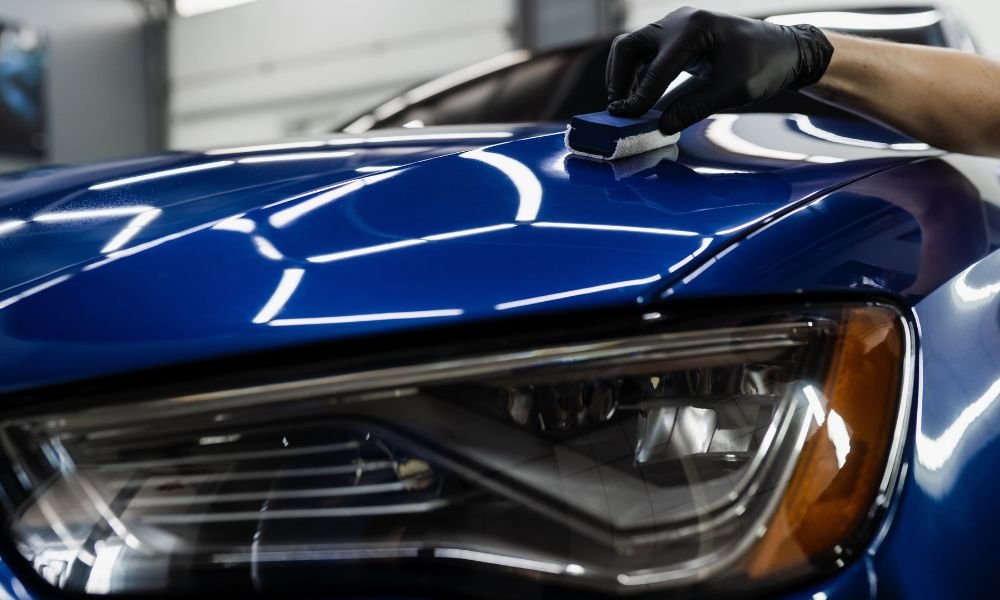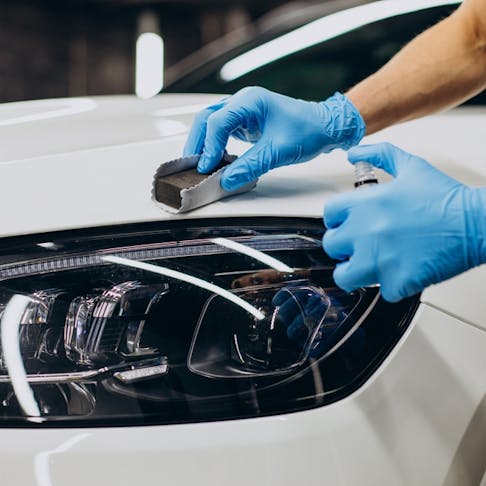Checking out the Scientific Research Behind Car Ceramic Coating and Its Safety Properties
The science of car ceramic coating provides a fascinating study in sophisticated auto protection. Made up mostly of silicon dioxide and polymers, these layers create a robust bond with lorry paint. This interaction enhances longevity versus environmental hazards while providing hydrophobic benefits. The complexities of just how these layers work and their long-term advantages continue to be much less recognized. Ceramic Coating Newark. Unloading these details exposes why ceramic coatings are coming to be a favored selection for vehicle treatment
What Is Ceramic Coating?
Ceramic coating is a liquid polymer that chemically bonds to the surface of a vehicle's paint. This advanced protective layer enhances longevity and offers remarkable resistance to environmental elements. Unlike standard wax or sealers, which offer momentary security, ceramic layers produce a lasting shield that can stand up to rough problems such as UV rays, acidic contaminants, and severe climate. When used appropriately, the coating forms a hydrophobic surface area, causing water to bead and slide off, which assists in keeping the lorry's cleanliness. In addition, it offers improved gloss and deepness to the paint, making the vehicle show up even more sleek and dynamic. The application process usually entails comprehensive surface area prep work, including cleansing and sprucing up, to guarantee peak bonding. Therefore, ceramic finishings are ending up being significantly popular among car fanatics and those looking for to secure their financial investments, assuring to preserve the car's aesthetic charm while reducing the frequency of maintenance.
The Composition of Ceramic Coatings
The complex formula of ceramic coverings mainly contains silicon dioxide (SiO2), which is originated from natural resources like quartz and sand. This crucial element gives the structure for the coating's durability and safety high qualities. In addition to SiO2, ceramic coverings typically consist of various polymers and ingredients that boost adhesion, adaptability, and resistance to environmental variables. These compounds work synergistically to produce a durable obstacle against contaminants such as dust, chemicals, and UV rays.Furthermore, some formulations incorporate titanium dioxide (TiO2) or other nanomaterials, which can increase the coating's hydrophobic residential properties, resulting in better water repellency. The precise composition can differ considerably amongst suppliers, influencing efficiency and durability. Inevitably, the mix of these elements finishes in a safety layer that not only enhances the visual appeal of cars however additionally serves to extend their life expectancy by protecting the surface area from potential damage.
Exactly How Ceramic Coatings Work
Understanding just how ceramic finishings function includes discovering their chemical structure, which adds to their protective top qualities. The application process is crucial for achieving suitable outcomes, while long life and toughness variables identify the coating's performance over time. Together, these aspects highlight the advantages and efficiency of ceramic layers for lorry security.
Chemical Composition Explained
While numerous car owners seek durable protection for their automobiles, the chemical composition of ceramic finishes plays a vital role in their effectiveness. These coatings mainly consist of silicon dioxide (SiO2), which is obtained from natural minerals. This compound forms a solid bond with the lorry's paint, producing a long lasting, protective layer. Furthermore, numerous ceramic coatings contain titanium dioxide (TiO2), boosting their hydrophobic homes and resistance to UV rays. The presence of polysiloxanes can even more boost flexibility and toughness. Together, these components add to the coating's capacity to drive away water, dirt, and impurities, while also providing a high-gloss surface. Understanding this chemical foundation helps car proprietors value the robust defense supplied by ceramic finishes.
Application Process Introduction
Applying ceramic coatings includes a meticulous process that guarantees suitable bonding and security for the car's surface. Thorough cleaning and purification of the car's outside are performed to eliminate dust, gunk, and previous waxes. This step confirms that the surface is devoid of impurities that could prevent bond. Following this, the paint is usually brightened to enhance quality and eliminate any type of flaws. Once prepared, the ceramic coating is used in little areas utilizing an applicator pad, permitting consistent coverage. The coating is then delegated cure, creating a strong chemical bond with the surface area. Proper treating times and problems are vital, as they confirm the coating attains its optimum efficiency and protective top qualities.
Durability and Durability Aspects
Ceramic layers are created to supply lasting security with their innovative chemical make-up, which creates a durable barrier against environmental contaminants. The durability of these layers is influenced by factors such as the thickness of the application, the top quality of the product, and the problems under which the vehicle is subjected. Top quality ceramic finishes can last several years, withstanding scrapes, UV rays, and chemical discolorations. Proper maintenance, including regular washing and periodic reapplication, can further enhance durability. In addition, environmental elements like climate and direct exposure to contaminants can influence the life-span of the coating. On the whole, when applied and kept appropriately, ceramic coatings supply phenomenal resilience, making them a popular choice for car fanatics seeking to protect their vehicle's look.
Hydrophobic Features and Water Repellency
Hydrophobic buildings are a hallmark of quality car ceramic layers, substantially enhancing the car's surface efficiency. These finishings create a molecular bond with the car's paint, leading to a surface area that wards off water successfully. When water enters into contact with a ceramic-coated surface, it grains up and rolls off, decreasing the quantity of liquid that stays on the paint. This habits not just adds to a cosmetically pleasing look however also minimizes the accumulation of impurities such as dirt, top article gunk, and road salts.The improved water repellency causes simpler cleaning and upkeep, as less initiative is called for to eliminate click over here unwanted compounds. Furthermore, the hydrophobic nature of ceramic finishings helps in preventing water spots, which can mar the finish of uncoated surfaces. On the whole, the consolidation of hydrophobic residential properties in ceramic coatings plays an essential function in preserving the car's excellent look while simplifying maintenance.
Security Against Scratches and UV Damage
Car ceramic finishes use considerable security against scratches and UV damage. The scratch resistance device produces a sturdy layer that soaks up influences, while the UV protecting benefits assist keep the lorry's paint stability gradually. With each other, these functions contribute to a longer-lasting and aesthetically attractive surface.
Scratch Resistance Device
Utilizing sophisticated technology, ceramic coverings supply a durable shield versus scratches and UV damage, boosting the longevity and appearance of automobile surfaces. The scratch resistance device of these finishings is attributed to their special molecular framework, which develops a durable bond with the lorry's paint. This bond develops a hard, safety layer that can soak up influences and withstand abrasions. Furthermore, the smooth surface of the coating reduces rubbing, making it challenging for pollutants to adhere and create scratches. The chemical make-up of ceramic coatings often consists of nanoparticles that enhance the safety layer, more boosting its durability. Automobiles treated with ceramic layers exhibit considerably boosted scrape resistance contrasted to conventional wax or sealers, making certain an immaculate surface over time.
UV Shielding Benefits
The safety high qualities of ceramic layers extend beyond scratch resistance to consist of significant UV protecting benefits. These coatings develop a robust obstacle that shows hazardous ultraviolet rays, securing the car's paint and underlying products. Prolonged direct exposure to UV radiation learn the facts here now can cause fading, oxidation, and deterioration of the paint finish. By including ceramic layers, car owners can effectively mitigate these threats, preserving the visual appeal and honesty of their autos. Additionally, the UV blocking properties add to improved longevity, minimizing the frequency of repainting and maintenance. Ultimately, the integration of ceramic coatings offers a detailed solution for safeguarding automobiles from the destructive impacts of sunlight exposure, making sure a continual, vibrant appearance gradually.
The Long life and Upkeep of Ceramic Coatings

Often Asked Concerns
Can Porcelain Coating Be Applied to Any Kind Of Type of Lorry?
Ceramic coating can be applied to numerous sorts of automobiles, including automobiles, vehicles, and bikes. Surface area prep work and compatibility with details products are necessary for optimal bond and performance of the coating.
Just How Much Does Ceramic Coating Normally Cost?
Ceramic coating generally sets you back in between $500 and $2,000, depending upon elements such as vehicle size, coating quality, and expert application. The investment can offer durable security and improve the automobile's appearance gradually.

Is Professional Application Essential for Ideal Outcomes?
The requirement of specialist application commonly depends on preferred outcomes. Specialists commonly ensure proper surface area prep work and application methods, resulting in perfect bonding and long life of the coating, which may be testing for unskilled individuals to achieve.
Can Ceramic Coatings Be Removed or Repaired?
Ceramic finishes can be removed or fixed, though the procedure might call for particular solvents or methods - Ceramic Coating Newark. Proper elimination is vital to avoid damage to the underlying surface, stressing the relevance of expert aid for excellent results
Just How Does Ceramic Coating Contrast to Standard Wax?
The contrast in between ceramic coating and standard wax exposes that ceramic layers supply exceptional longevity, improved security versus environmental pollutants, and longer-lasting sparkle, while wax calls for extra regular application and supplies less overall resistance to damage.